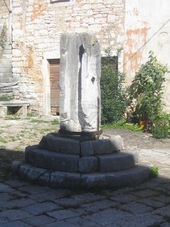to enlarge


or choose the place
from the menu below
 Rome |
 Byzantium |
 Venice |
 Vienna |
 Brioni |
 Smrikve |
 |
 |
If you walk towards west, on the left side of the big gate, after fifteen meters, on your left side, opposite to the town walls, in the countryside, you will note the ruins of the Church of St. Odoric.
The town walls that you can see in this part were originally built in the 10th – 12th century. The town was expanded by Venetians in the 14th and 15th century for the part that is located on the right side of the big gate.
_small.jpg) You can turn back near the big gate and nearby the gate, on the left side, you will note the Goat
sculpture of Giorgio Celiberti.
You can turn back near the big gate and nearby the gate, on the left side, you will note the Goat
sculpture of Giorgio Celiberti.
A similar goat sculpture of the same artist can be seen in Buje.
When you pass the big gate you will note, at the end of the street, a harmonious Municipal loggia from the 15th century that today houses a rich collection of stones with monuments from Antiquity and the Romanesque period.
_small.jpg) The coat of arms placed inside of it are those of the Istrian families: Barbaro, Foscarini and
Salomon. The one on the pillar with a Lion of St. Mark above it is the coat of arms of the Salomon family.
The coat of arms placed inside of it are those of the Istrian families: Barbaro, Foscarini and
Salomon. The one on the pillar with a Lion of St. Mark above it is the coat of arms of the Salomon family.
In the middle of the road, between the big gate and the Municipal loggia, on your left side, you will note a house with Renaissance window that dates back into the 15th century.
There are very few architecture elements from the Renaissance period. You can find very few houses in Svetvincenat, Mutvoran, Tinjan and Umag.
 The lack of the Renaissance experience
is probably due to the fact that major part of Istria was part of the Venice Republic that at the time of the Renaissance
period was still a super power. I believe that due to that reason the predominance of the Venetian architecture is typical
for many Istrian towns.
The lack of the Renaissance experience
is probably due to the fact that major part of Istria was part of the Venice Republic that at the time of the Renaissance
period was still a super power. I believe that due to that reason the predominance of the Venetian architecture is typical
for many Istrian towns.
In front of the Municipal loggia you will note the Venetian pillar from 1653. On the right side of the Municipal loggia there is 21 meters high bell tower from the 14th century.
The bell tower has been constructed on the eastern entrance tower so that it has been incorporated into the preserved town walls. A walled up opening with a Gothic sharp arch, very similar to the big gate, is clearly visible at the base of the tower.
_small.jpg) If you walk nearby the bell tower, the house with the stairs that you find on the angle
in front of the bell tower dates back into the 15th century. It is worth to remember that originally Sv. Lovrec had nine defence
towers.
If you walk nearby the bell tower, the house with the stairs that you find on the angle
in front of the bell tower dates back into the 15th century. It is worth to remember that originally Sv. Lovrec had nine defence
towers.
Once you arrive in front of the bell tower you will note few stairs, located on the left side of the bell tower nearby the base of it. The ruins of the building you can see are practically part of the town walls; this was the old “fondaco”, the granary storage house that dates back into the 13th century.
From that position you will see the back of the Parish Church of St. Martin that dates back the into 11th century, while the main façade is from 1838.
The back of the church is particular for its three half circle apses. You can turn back and go to visit the current main façade of the Parish Church.
The church hosts several art works and also the organ was built by Nanchini from Vicenza and is interesting that this organ was used when Pope Pio VII was elected in Venice in 1800. Later on the organ was transferred in the church of Dajla and today is here in Sv. Lovrec